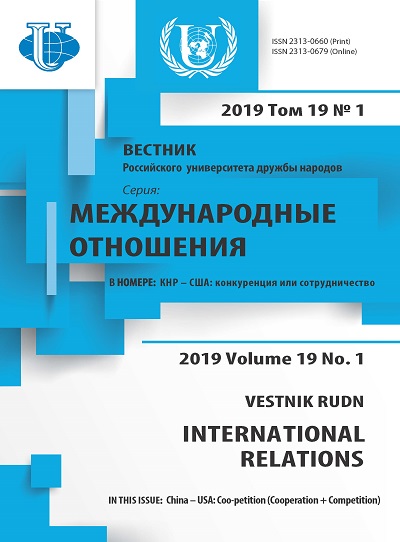Значение стратегии «Один пояс, один путь» для Китая и Евразии
- Авторы: Чэн Г.1, Чэнь Л.2, Дегтерев Д.А.1, Чжао Ц.1
-
Учреждения:
- Российский университет дружбы народов
- Университет науки и технологий Нанкина Нанкин
- Выпуск: Том 19, № 1 (2019): КНР — США: конкуренция или сотрудничество
- Страницы: 77-88
- Раздел: МЕЖДУНАРОДНЫЕ ЭКОНОМИЧЕСКИЕ ОТНОШЕНИЯ
- URL: https://journals.rudn.ru/international-relations/article/view/20853
- DOI: https://doi.org/10.22363/2313-0660-2019-19-1-77-88
- ID: 20853
Цитировать
Полный текст
Аннотация
Инициатива «Один пояс, один путь» была предложена президентом Китая Си Цзиньпином во время его визитов в Казахстан и Индонезию в 2013 г. Данная инициатива может восприниматься в качестве инструмента как внутренней экономической, так и внешней политики КНР. Стратегия призвана укрепить Китай как привлекательного игрока на мировом рынке и усилить его мягкую силу. Реализация стратегии предусматривает в основном расширение экономических обменов между Китаем и внешним миром. Исторически концепция «Шелкового пути» была ориентирована не только на развитие международной торговли. Она также имеет значительную гуманитарную составляющую. Очевидно, что данная инициатива будет служить культурным мостом между Китаем и зарубежными странами и в этом смысле способствует формированию диалога между цивилизациями, а не только между рынками или крупнейшими мировыми игроками. Китай с его долгосрочными интересами рассматривает «Один пояс, один путь» как важную составляющую своей большой стратегии. Эта инициатива широко обсуждается учеными и политиками как в Китае, так и за его пределами. В статье показаны координация усилий Китая и России по вопросам регионального развития, а также интернационализация региона Центральной Азии после 1991 г. и роль Китая в этом процессе. Описаны контуры возможного соперничества великих держав, а также отсутствия взаимного политического доверия между странами Центральной Азии в контексте реализации стратегии. Данная статья позволяет взглянуть на вопрос реализации стратегии «Один пояс, один путь» с точки зрения китайских исследователей.
Об авторах
Го Чэн
Российский университет дружбы народов
Автор, ответственный за переписку.
Email: ivanclee25@gmail.com
аспирант кафедры теории и истории международных отношений Российского университета дружбы народов
Лу Чэнь
Университет науки и технологий Нанкина Нанкин
Email: hanfeng68@sina.com
профессор Университета науки и технологий Нанкина
Денис Андреевич Дегтерев
Российский университет дружбы народов
Email: degterev-da@rudn.ru
кандидат экономических наук, доцент, заведующий кафедрой теории и истории международных отношений Российского университета дружбы народов
Цзелинь Чжао
Российский университет дружбы народов
Email: zhaojielin@163.com
аспирант кафедры теории и истории международных отношений Российского университета дружбы народов
Список литературы
- Бадрутдинова К.Р., Дегтерев Д.А., Степанова А.А. Отношения в треугольнике США—РФ—КНР: соблюдается ли формула лидерства Г. Киссинджера? // Вестник международных организаций. 2017. Т. 12. № 1. С. 81—109. doi: 10.17323/1996-7845-2017-01-81.
- Виноградов А.В. Политика и экономика: 35 лет дискуссии // «18 съезд КПК: новые задачи и перспективы развития». Материалы ежегодной научной конференции Центра политических исследований и прогнозов ИДВ РАН. Информационные материалы. Серия В «Общество и государство в Китае в период реформ». М., 2013. Вып. 28. С. 65—75.
- Дадабаев Т. «Шелковый путь» как внешнеполитический дискурс: построение китайских, японских и корейских стратегий взаимодействия в Центральной Азии // Журнал евразийских исследований. 2018. Т. 9. № 1. С. 30—41. DOI: https://doi.org/10.1016/j.euras.2017.12.003.
- Дегтерев Д.А., Ли Я., Трусова А.А., Черняев М.С. Приоритетные направления российской и китайской помощи в целях развития странам Азии и Африки: сравнительно-сопоставительный анализ // Вестник Российского университета дружбы народов. Серия: Международные отношения. 2018. Т 18. № 4. С. 888—905. doi: 10.22363/2313-0660-2018-18-4-888-905.
- Костюнина Г.М., Баронов В.И. Особенности региональных интеграционных соглашений с участием Китая в рамках модели Юг—Юг // Вестник Российского университета дружбы народов. Серия: Международные отношения. 2018. Т. 18. № 3. С. 612—627. doi: 10.22363/2313-0660-2018-18-3-612-627.
- Лукин А., Якунин В. Евразийская интеграция и развитие азиатской России // Журнал евразийских исследований. 2018. Т. 9. № 2. С. 100—113. DOI: https://doi.org/10.1016/j.euras.2018.07.003.
- Муратшина К.Г. Программа сотрудничества регионов Дальнего Востока и Восточной Сибири РФ и Северо-Востока КНР на 2009—2018 гг. в российско-китайском трансграничном взаимодействии: значение, эволюция, риски // Вестник Томского государственного университета. 2017. № 417. С. 110—121. DOI: 10.17223/ 15617793/417/16.
- Рахимов К.К. Инфраструктурные проекции геоэкономики в Центральной Азии // Вестник Российского университета дружбы народов. Серия: Международные отношения. 2014. № 4. С. 137—147.
- Юртаев В.И., Рогов А.С. ШОС И БРИКС: Особенности участия в процессе евразийской интеграции // Вестник Российского университета дружбы народов. Серия: Международные отношения. 2017. Т 17. № 3. С. 469—482. doi: 10.22363/2313-0660-2017-17-3-469-482.
- Ягья В.С., Харлампьева Н.К., Лагутина М.Л. Арктика — новый регион внешней политики Китая // Вестник Российского университета дружбы народов. Серия: Международные отношения. 2015. № 1. С. 43—52.
- Denoon D. China, The United States, and the Future of Central Asia: U.S. — China Relations, Vol. 1. N.Y.: New York University Press, 2015.
- Dobbins J. Conflict with China: Prospects, Consequences, and Strategies for Deterrence. RAND: Arroyo Center, 2018. URL: https://www.rand.org/content/dam/rand/pubs/occasional_papers/2011/RAND_OP344.pdf (accessed: 17.12.2018).
- Du D., Ma Y. One Belt One Road: Grand geo-strategy for the rising China // Geographical Research. 2015. Vol. 34. No. 6. P. 1005—1014.
- Fergusson I.F., Williams B.R. The Trans-Pacific Partnership (TPP): Key Provisions and Issues for Congress. Congressional Research Service, 2016. 7-5700. R44489. URL: https://fas.org/sgp/crs/row/R44489.pdf (accessed: 26.10.2018).
- Haas M. Relations of Central Asia with the Shanghai Cooperation Organization and the Collective Security Treaty Organization // The Journal of Slavic Military Studies. 2017. Vol. 30. No. 1. P. 1—16.
- Zhu C., Han J. The Status Quo of FTAs along the Proposed Route of the “Belt and Road Initiative” and China’s FTA Strategy // Asia-Pacific Economic Review. 2015. No. 4. P. 44—50.
- Khan M., Sandano I., Pratt C., Farid T. China’s Belt and Road Initiative: A Global Model for an Evolving Approach to Sustainable Regional Development // Sustainability. 2018. Vol. 10. No. 11. P. 1—20. doi: 10.3390/su10114234.
- Song G. China’s Free Trade Agreement Strategies // The Washington Quarterly. 2012.Vol. 35. No. 4. P. 107—119. DOI: https://doi.org/10.1080/0163660X.2012.726425.
- Vinokurov E., Libman A. Eurasian Integration: Challenges of Transcontinental Regionalism. London: Palgrave Macmillan, 2012.
- Wuthnow J. Chinese Perspectives on the Belt Road Initiative: Strategic Rationales, Risks, and Implications. Center for the Study of Chinese Military Affairs, Institute for National Strategic Studies. Washington: National Defense University, 2017.
- Zeng K. China’s Free Trade Agreement Diplomacy // The Chinese Journal of International Politics. 2016. Vol. 9. No. 3. P. 277—305. DOI: https://doi.org/10.1093/cjip/pow009.
Дополнительные файлы










